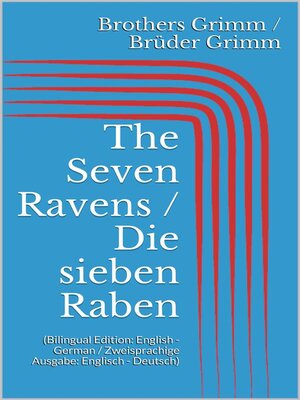
Sign up to save your library
With an OverDrive account, you can save your favorite libraries for at-a-glance information about availability. Find out more about OverDrive accounts.
Find this title in Libby, the library reading app by OverDrive.



Search for a digital library with this title
Title found at these libraries:
| Library Name | Distance |
|---|---|
| Loading... |
This edition contains the English translation and the original text in German.
"The Seven Ravens" is a German fairy tale collected by the Brothers Grimm. It is tale number 25, and Aarne-Thompson type 451, the brothers who were turned into birds. Georgios A Megas collected another, Greek variant in "Folktales of Greece". Other variants of the Aarne-Thompson type include "The Six Swans", "The Twelve Wild Ducks", "Udea and her Seven Brothers", "The Wild Swans", "The Twelve Brothers", and "The Magic Swan Geese". An animated feature film based on the story was released in 1937.
"Die sieben Raben" ist ein Märchen (ATU 451). Es steht in den Kinder- und Hausmärchen der Brüder Grimm an Stelle 25 (KHM 25). In der Erstauflage hieß das Märchen "Die drei Raben". Ludwig Bechstein übernahm es in sein Deutsches Märchenbuch als "Die sieben Raben" (1845 Nr. 25, 1853 Nr. 24).
"The Seven Ravens" is a German fairy tale collected by the Brothers Grimm. It is tale number 25, and Aarne-Thompson type 451, the brothers who were turned into birds. Georgios A Megas collected another, Greek variant in "Folktales of Greece". Other variants of the Aarne-Thompson type include "The Six Swans", "The Twelve Wild Ducks", "Udea and her Seven Brothers", "The Wild Swans", "The Twelve Brothers", and "The Magic Swan Geese". An animated feature film based on the story was released in 1937.
"Die sieben Raben" ist ein Märchen (ATU 451). Es steht in den Kinder- und Hausmärchen der Brüder Grimm an Stelle 25 (KHM 25). In der Erstauflage hieß das Märchen "Die drei Raben". Ludwig Bechstein übernahm es in sein Deutsches Märchenbuch als "Die sieben Raben" (1845 Nr. 25, 1853 Nr. 24).







